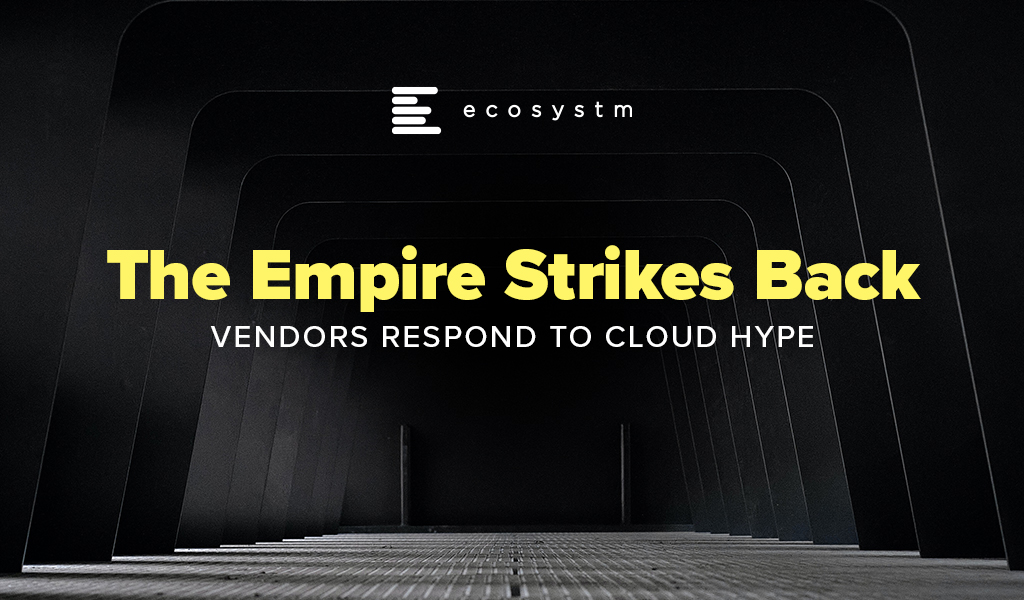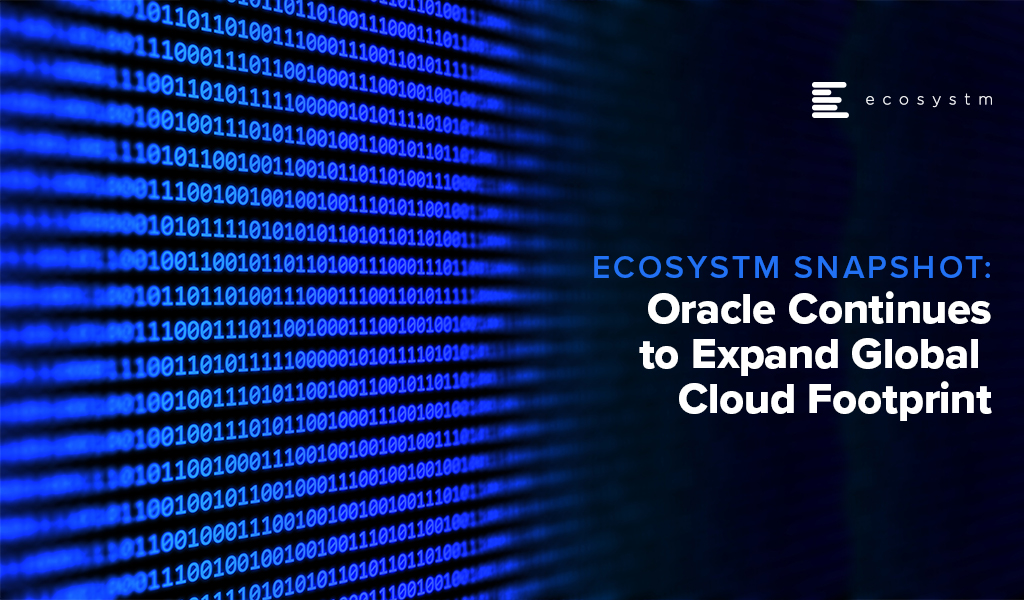“Cloud is universal – everything is going to be on the cloud soon! If you are not moving to the cloud, you are going extinct! AWS, Microsoft and Google are going to rule the world!” This has been the hyped narrative for some time now. But watch out New World – the Old World is fighting back!
Traditional vendors like HP Enterprise, Cisco, and Oracle are all deploying strategies to remain relevant in the new world. For these vendors – especially for HPE and Cisco that come from a predominantly hardware background – the future is hybrid. They picture a world in which the data centre – either on-prem or in a co-located facility – thrives on, in tandem with the cloud. This is a reasonably good bet. For most large enterprises with a huge repository of applications and data sitting in the data centre, migrating everything to the cloud is a nightmare – fraught with risk and very expensive.
Ecosystm research shows that 32% of organisations have deployed containerisation – and this percentage will only grow. The ability for firms to toggle between data centre bare metal based applications and completely on-the-cloud ones is becoming more manageable by the day. This enormous flexibility allows a firm that has large compute needs to keep some stable workloads in a data centre, whether on-prem or co-located, while simultaneously using cloud-based workloads, optimising spends and performance.
Here is a glimpse into the strategies of three key vendors.
HPE’s ‘as-a-service’ Messaging is Spot on
Two years ago, Antonio Neri boldly went where no HPE CEO had gone before, promising that HPE’s entire portfolio would be available ‘as-a-service’ within 3 years. At the recently concluded HPE Discover event, there were a flurry of announcements to showcase that GreenLake is indeed on its way to meet that ambitious goal in 2022.
HPE’s recent announcements show customers that GreenLake is an end-to-end solution for managing their IT infrastructure moving forward. It ticks all the boxes: providing flexibility and scalability; the advantage of using both data centre and cloud; and high manageability and security with a full suite of applications.
Examples are the partnership with Azure Stack HCI, to add to earlier ones with leading vendors like SAP, Citrix, and VMware. HPE is building a platform that provides customers with the comfort that they can adopt GreenLake and pretty much have access to any application they may choose to implement – offering full coverage from the Edge to the Cloud. It is extremely interesting that GreenLake allows the option of switching on and switching off processor cores as needed, and the customer pays based on usage. This is surely a first for the industry!
Another example is Lighthouse, which allows the customer to rapidly configure, and provision workloads based on dynamic needs. While all the hyperscalers provide similar services when the workload is on the cloud, Lighthouse allows the same flexibility and speed for cloud services which can be run in the data centre, on-prem, co-located, or even at the Edge.
A third example was the announcement of Project Aurora which will add an additional security layer from validating the input data all the way to verifying the workload at the start and then as it is running. It appears to use an AI/ML system that checks for unexpected behaviours to detect any kind of malware.
It makes good sense for HPE to push GreenLake and move to offering ‘everything-as-a-service’. As one of the incumbent enterprise hardware business leaders, this is a good response rather than to watch one’s business continue to shrink YoY. GreenLake is HPE’s way of futureproofing themselves and making sure they stay relevant in the new cloud world.

Cisco Secures the Hybrid Workplace
Cisco has been active launching Cisco Plus earlier this year, as their bridge to the as-a-service model with a network-as-a-service (NaaS) offering. Somewhat like GreenLake, Cisco Plus offers flexible consumption for compute, storage, and networking. They are committed to offering most of their portfolio as-a-service over time.
Cisco has shown some resilience in terms of revenue but has still been struggling to grow. After a steady growth since 2017, the revenues dropped by 7% in 2020 almost as a direct impact of COVID-19. The post-pandemic world has the potential of being a bigger threat for Cisco. Many estimates show the number of people working from home is likely to go up dramatically and Cisco’s key networking offering could rapidly become redundant. However, at Ecosystm we believe that the hybrid work model will be predominant.
Cisco is also betting on a hybrid world. No matter where one works from, there are networking needs. Cisco’s focus, therefore, is on security – this will be on the mind of virtually any enterprise as it chalks out its future strategy. With a hybrid environment, making everything secure becomes more complex while continuing to be vital. Cisco has a heavy emphasis on Secure Access Service Edge (SASE) – the idea that the security envelope now has to be a flexible form that has a presence everywhere that the enterprise needs to be. This will make a lot of sense to most enterprises as they tread the hybrid path.
Cisco will offer a portfolio of tools to make it increasingly easier for customers to use multi-cloud, multi-vendor environments, offering the best of both worlds.
Oracle Incentivises Cloud Migration
Oracle has a different approach because they are trying to solve a different problem. They are competing with the hyperscalers, while fully acknowledging a hybrid world. However, as a company with less legacy in hardware, it makes sense for them to focus on migrating to cloud rather than on hybridisation. Oracle has just announced that they will subsidise existing customers who add cloud workloads with them, by providing discounts on the existing licensing fees that the customer is paying Oracle. This discount appears to be around 25% to 33%. In essence, this means that if a customer spends about USD 100k with Oracle on licensing and decides to start moving workloads to the Oracle Cloud worth somewhere between USD 300-400k, they can potentially write off the entire license fees they are currently paying!
Conclusion
There is a strong effort from every vendor right now to retain and consolidate their customer share and build a vision that convinces the customer that they are the way to go. For the traditional hardware players that vision is of a hybrid world – attractive to today’s large enterprise. For the likes of AWS, Microsoft, Google, and Oracle it is all about moving the customer to their cloud. The assumption of course is that moving someone to your cloud will lead to more of your apps being used by the customer. For the hardware vendors like Cisco and HPE, it is all about moving the customer to their own platforms which empower hybridisation. In all cases, a necessary component is to offer ‘everything-as-a-service’ upending the traditional models of selling.
In my opinion, with time the IaaS portion of the cloud is likely to gradually devolve into something like a utility. There will be a lot of upheavals and market disruption before we get there, but eventually, software and other services are likely to stand separate from the infrastructure provider. All the vendors are therefore depending on capturing the customer at the platform-as-a-service (PaaS) level, but even this is likely to get commoditised over time. Eventually, the winners will be disparate providers of the best applications for different functions. Meanwhile, we are in for an extremely interesting ride as we see all the vendors jockeying for space!

In the Top 5 Cloud Trends for 2020, Principal Analyst Claus Mortensen observed that 2020 is a do-or-die year for Oracle if they wanted to remain as a key contender in the Cloud market. Mortensen said, “Oracle has not been able to break into Cloud in the same way as their competitors and has so far not made the same “leap of faith” into this area as similar companies have. Unless the company makes a clear decision about their Cloud strategy and succeeds in communicating it to the market in 2020, Oracle may quickly find itself more of a niche Cloud player going forward.”
Oracle’s intentions to remain one of the leading global Cloud providers becomes clear as they actively expand their global coverage. Last week Oracle announced that, as part of their ongoing regional expansion plan, they have added local regions in Jeddah (Saudi Arabia), Melbourne (Australia), Osaka (Japan), Montreal (Canada) and Amsterdam (The Netherlands). This expands the reach of Oracle’s Generation 2 Cloud to 21 independent locations, and Oracle intends to further add 15 locations by the end of 2020. At OpenWorld last year, Oracle had announced their plans to have Cloud sites dedicated to the enterprise market as well as government customers.
Dr Alea Fairchild, Principal Advisor Ecosystm, thinks that Oracle appreciates the needs of their enterprise customers. “Oracle understands the sensitivity of the enterprise to the location and availability of their data, which remains an issue with Cloud implementations involving large data sets. They have broken some ground as the first public Cloud vendor with data centres in Saudi Arabia, and are putting efforts in to offer a minimum of two regions in almost every country in which they operate,” says Dr Fairchild. “From a corporate user’s perspective, regional data management and appropriate licensing models are still sensitive spots when it comes to database management.”
Getting Ready for the Hybrid Cloud Market
Oracle also appears to be ramping up for the growing hybrid Cloud market. Ecosystm research shows that more than a third of global organisations have adopted the hybrid Cloud and this will only increase. Given the increased uptake of hybrid and multi-cloud environments, Oracle offers preconfigured links between Oracle and Microsoft Azure cloud regions in the eastern states of the US, London, and Toronto, as part of the Cloud interoperability partnership announced in June 2019. Last year, saw another mutually beneficial partnership between VMWare and Oracle, that supports their customers’ hybrid cloud strategies, allowing the VMware Cloud Foundation to run on Oracle Cloud Infrastructure. Organisations can also avail technical support for Oracle software running in VMware environments both in on-premise data centres and Oracle-certified cloud environments.
“Oracle’s Generation 2 Cloud is now available in 21 locations and is on track to have a total of 36 Cloud regions up and running by the end of the year,” adds Dr Fairchild. “But when compared to AWS, Microsoft and IBM, Oracle still holds a fraction of the market share. They can be seen as a niche infrastructure provider, but indeed the partnerships with Microsoft and VMware are set to help Oracle’s Cloud business make traction with companies that are adopting multi-cloud strategies.”



